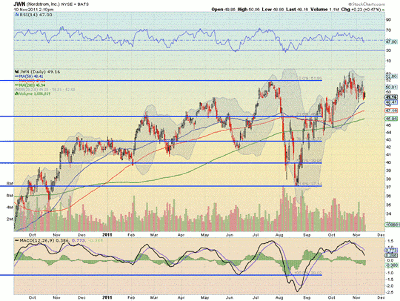Greg Harmon of Dragonfly Capital uses many different option trading strategies. He continues this multi-part series with a detailed explanation and recent example of a put butterfly spread.
There are many different strategies that I use with options, and over the next few weeks, I will continue to go through some of them to help explain the strategy and how it can be used to access the markets with controlled risk.
(Read the first article in this series on the Call Spread Risk Reversal.)
The Put Butterfly Strategy
This strategy consists of buying one put option, selling two lower-strike put options, and then buying a third lower-strike put option to create the butterfly. The strikes of the three puts should be equal distance from each other. In this way, you are essentially long a put spread with the higher- and middle-strike puts and also short a put spread with the middle- and lower-strike puts, both of the same width.
Because of this symmetry, buying butterflies requires no margin. The profit is also capped to the width of the put spread, less the cost, and reaches its maximum at the middle-strike put, but the risk is also limited to the premium paid. Despite limited risk and reward, these trades can still have reward- to-risk ratios at the maximum payout of 5:1 or more.
This options trade is ideal for short-term events where there is a good degree of certainty about where the price may end up. For instance, a low-volatility stock as a short-term earnings play where the implied volatility suggests a move that will remain within support and resistance levels.
Let’s look at an example from a trade we took recently on Nordstrom (JWN).
The chart above shows JWN just after 2 pm last Thursday (Nov. 10). This is a bearish-looking chart and was corroborated with the weekly chart (contact me for more details). Support lower comes at $49, followed by $48, $47, and $44.70.
The trade we did was a November 49/47/45 put butterfly, buying the November 49 put, selling two November 47 puts, and then buying the November 45 put. At a cost of 30 cents, it is in the money for a range of $45.30-$48.30 at expiry and yields a maximum profit of $1.70 at $47.
Why did we do this trade? The options board showed an implied move of $3.20, or 6.5% from the at-the-money option. This created a tight range of $46.40-$52.80, just below the previous high. For the tight range, the put butterfly is a good way to cover the range at a low cost, and since the resistance at $47 was very near the bottom of the implied range at $46.40, the 47 put as the center strike was perfect.
The stock did drop after the earnings report to near $47 in the afterhours market and rebounded to end that session at $48.40. We may close this trade if it moves back lower after the open or at any time over the next week on a continued weak-looking chart.
By Greg Harmon of Dragonfly Capital






















